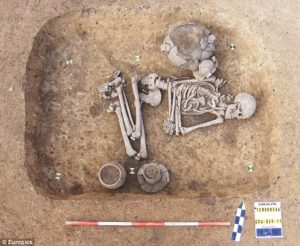As part of LGBTQIA+ history month, I wanted to spotlight a pre-modern historical find which demonstrates the complexities of gender identity and presentation throughout history. One claim that many transgender and gender non-conforming people are faced with is the assertion that their experiences are somehow a new phenomenon. The “we never had these ideas in my day” trope. What I hope to convey in this article is the fact that the gender binary as we know it has been transgressed in all cultures and all time periods in different ways, but that this is not always clear, as a result of the complex and strained interaction of academic history and the popular media. Historicising cultural ideas of gender throughout time can be incredibly rewarding, but is fraught with tensions.

On one of my frequent internet deep-dives (you know the ones – you start off researching something for a seminar and end up discovering that ketchup was actually first used as medicine), I stumbled across this archaeological find from 2011. A 5,000 year old skeleton was unearthed in a suburb of Prague, and later identified as male, dating from between 2900-2500 BC, and thus part of the Corded Ware culture of the copper age. What was striking about this discovery was that men in this civilisation were known particularly to be buried with weapons, particularly the highly symbolic stone axe, with their heads facing west. In contrast, this skeleton was found with their head facing east, surrounded by domestic jugs, typical of a female burial. As a result, Archaeologist Kateřina Semrádová told Czech Position: “We believe this is one of the earliest cases of what could be described as a ‘transsexual’ or ‘third gender grave’ in the Czech Republic.” Experts and public alike wondered if this was a male individual, female, both, or neither. Head of research team Kamila Remišová said “From history and ethnology, we know that when a culture had strict burial rules they never made mistakes with these sort of things.”
This is not the only find that has transcended or confused what we know about gendered cultural norms in historical civilisations: a nearby find of a female skeleton from the Mesolithic period was buried with weapons as a warrior around the 3rd century BC, and there are numerous examples of Viking burials with grave goods not assigned to the identified biological sex of the buried individual.
This discovery stood out to me particularly as it catalysed a media storm, featuring headlines like ‘The Oldest Gay in the Village: 5000 year old is outed by the way he was buried’ (Daily Mail), ‘You were born evolved this way: Archaeologists find first gay caveman’ (Perez Hilton), and ‘Stone age ‘Gender Bender’’ (Česká Pozice). Somehow the ambiguities of the individual’s gendered presentation have been conflated as evidencing their sexual orientation, with the feminine associations of the grave goods taken to determine male homosexuality. As anthropologist Kristina Killsgrove has pointed out, “sex, gender and the choice of sexual partner are not interchangeable terms”, but they have been used almost synonymously in the media coverage of the find. Archaeologist Monty Dobson agreed: “The reality of this is going to be far more complicated than, ‘This individual was gay'”. Indeed, there is no indicator for sexual orientation within the evidence, only an anomaly in what we know about gendered cultural practises in this period. As paleoanthropologist John Hawks had pointed out, “Not only is “gay” an oversimplification, “caveman” is flat-out inaccurate.”
So how did the unusual burial of a bronze-age farmer become a validation of ancient homosexuality?
The issue highlights a common problem with historicising gender, the difficulty of superimposing anachronistic cultural concepts and language onto an incompatible source, often in pursuit of media attention. When researching the transgender / third gender skeleton I found few sources, but searching for the ‘gay’ skeleton was much more fruitful. Killsgrove and Dobson pointed out that gender non-conformity frequently appeared in many cultures, particularly with individuals connected to the spirit world, who were often buried in unorthodox ways for their biological sex. Experts have also pointed out that though this skeleton may well evidence the existence of a transgender or gender-nonconforming individual, the identification of the skeleton as male rests only on a few measurements, and should not remain entirely unquestioned.
This is one of many examples of the complexities of studying gender through the lens of archaeology, but more so the dangers of retroactively applying modern social and cultural understandings on the past. In sensationalising this individual as a homosexual man, on account of the supposed effeminacy of his burial alone, the media has confused things even more. Many have contended that the individual may well have been what we would call transgender, but this is not an effective picture of the sociocultural nuances of gender identity in past civilisations. But I suppose this is a far less snappy headline!
Sources:
‘Gay Caveman’ Story Overblown, Archaeologists Say | Live Science
Gay Caveman! ZOMFG! (poweredbyosteons.org)
https://www.pinknews.co.uk/2011/04/06/5000-year-old-transgender-skeleton-discovered/
https://archaeologynewsnetwork.blogspot.com/2011/04/grave-of-stone-age-transsexual.html
For more, see Pamela L Geller, ‘The Fallacy of the Transgender Skeleton’ (2019)
